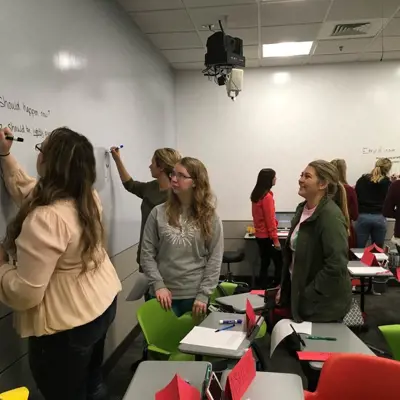
Enhancing learning through technology
Originally printed in Synapse, the College of Nursing and Health Professions newsletter
January 23, 2017
Imagine a classroom where students are encouraged to write on the walls, rearrange the furniture and use smart phones. There is not a front or back of the room - instead, the professor walks around constantly between students' seats, using a tablet to project photos and graphics onto a white wall. The white wall has been transformed into a giant touchscreen, and students are invited to come forward and draw directly on it with their fingertips. They are able to work in groups, drawing and writing on the wall, and even erasing content projected on the walls. The room has increased Wi-Fi to enable students to constantly peruse the Internet with their electronic devices, researching interesting ideas and best practices in the subject area, and then sharing their findings with the class via Apple TV and the Epson interactive projector.
This "smart room" is not in the future, but a new reality in the USI College of Nursing and Health Professions. Dr. Kevin Valadares, associate professor of Health Services said the first "smart room" he helped design in the Health Professions Center replaced a large room with a curtain divider.
64 traditional desks and a whiteboard on the back wall that hadn't been used since the building opened in 1994. The college used a donation from Dr. Victor V. Schriefer, Jr. to transform the room into "The Schriefer Interactive Classroom." It's now one of the most sought after areas for not only classes, but also meetings and workshops, because of the ease in configuring furniture and technology, including the flexibility to use healthcare apps and video-conferencing.
"Traditional classrooms are typically designed for passive learning. Students sit in desks - in straight rows facing the front - taking notes during a lecture or watching a PowerPoint," Valadares said. "Our smart rooms, allow students to be engaged, be creative and brainstorm in the classroom. It's the same philosophy that works in elementary school: students learn better when they can move and are comfortable. We are discovering this works with college students, too."
The most noticeable change in the new, interactive rooms is the furniture. Seating is both mobile and flexible, unlike traditional classroom desks. Tables and chairs roll easily, and some styles have built-in drink holders, hooks for portable whiteboards and a place to stash books and backpacks.
The College is now implementing this concept in various other areas throughout the building, including labs for diagnostic medical sonography, radiologic and imaging sciences, respiratory therapy and occupational therapy.
Originally printed in Synapse, the College of Nursing and Health Professions newsletter